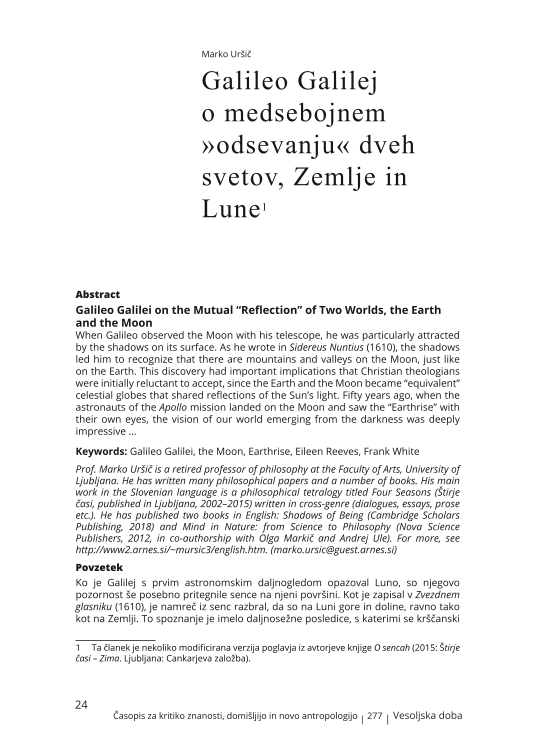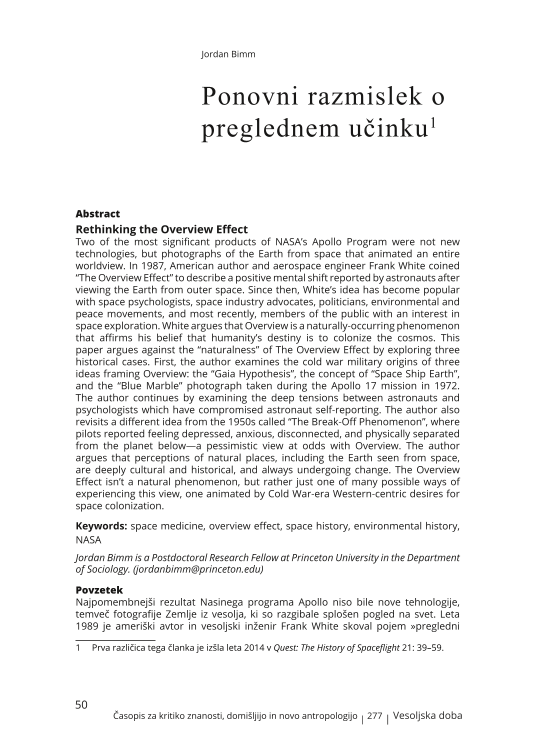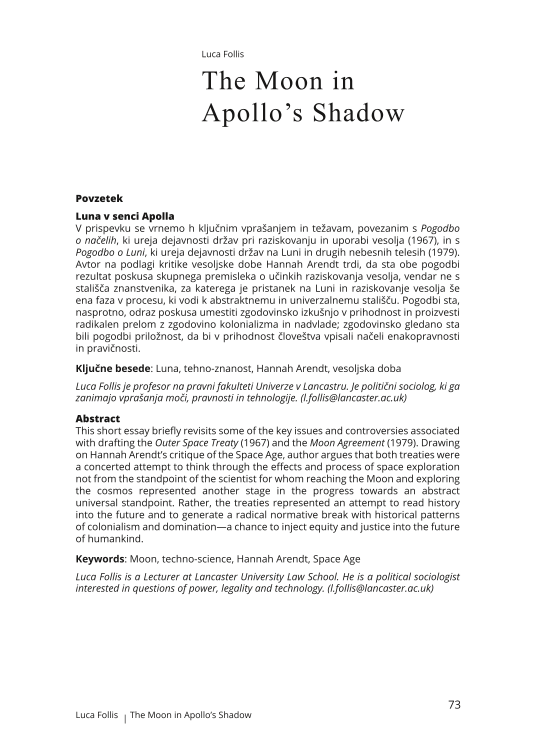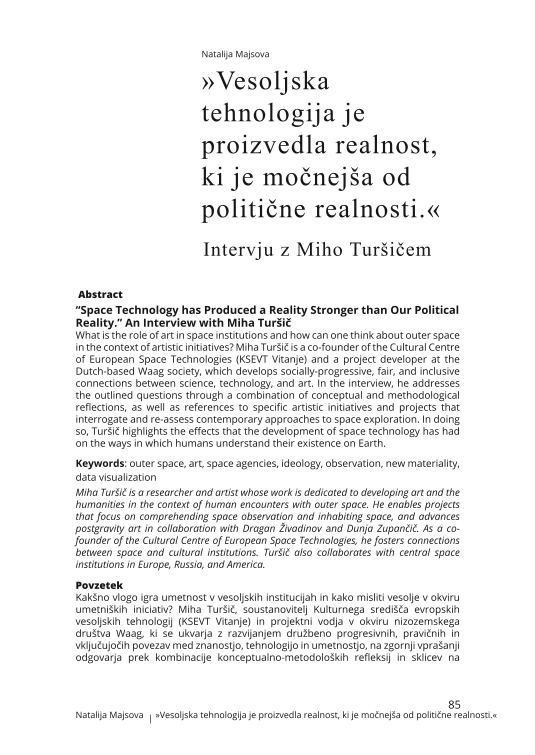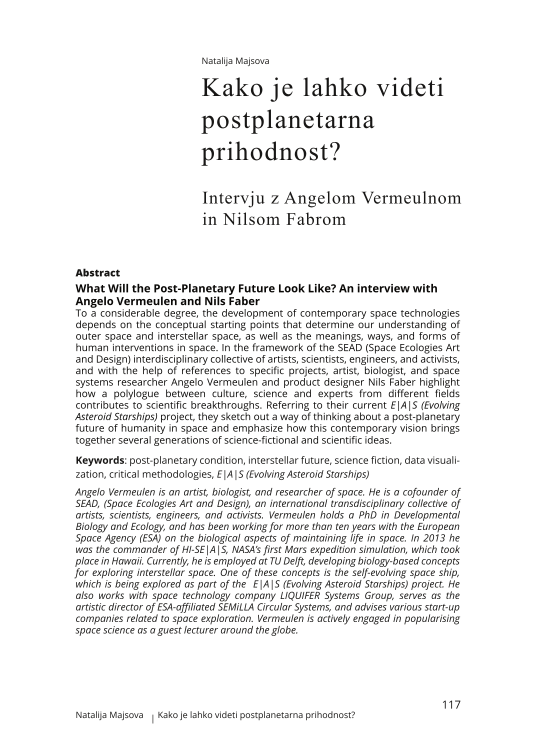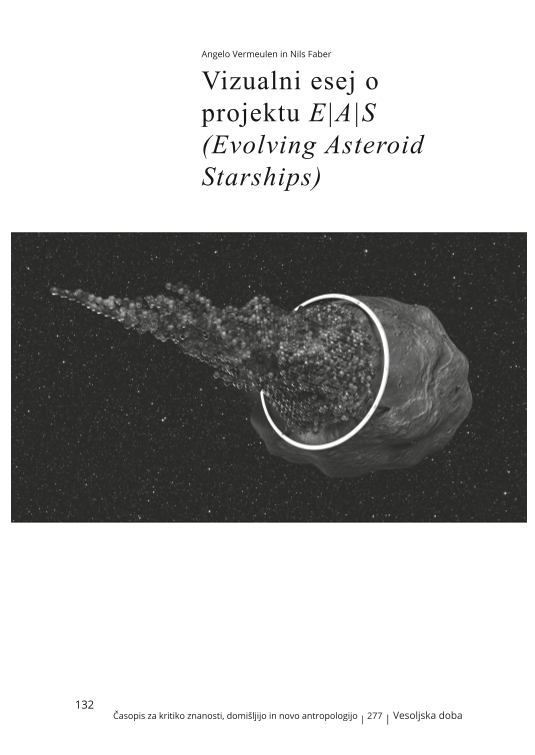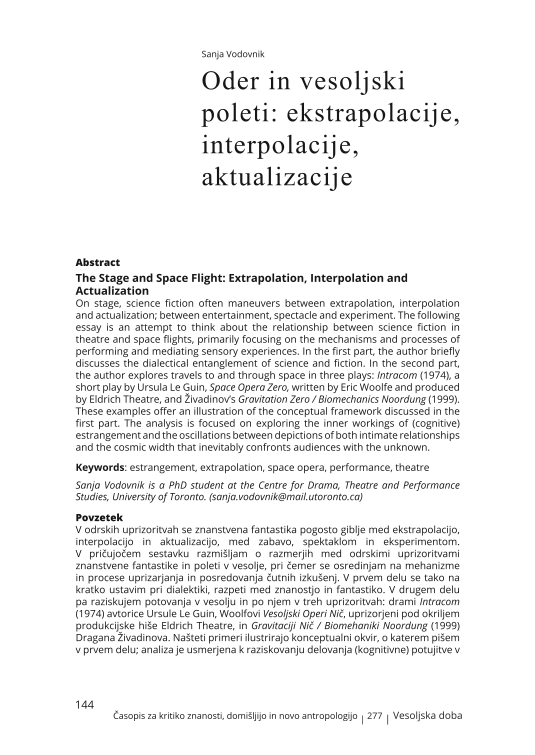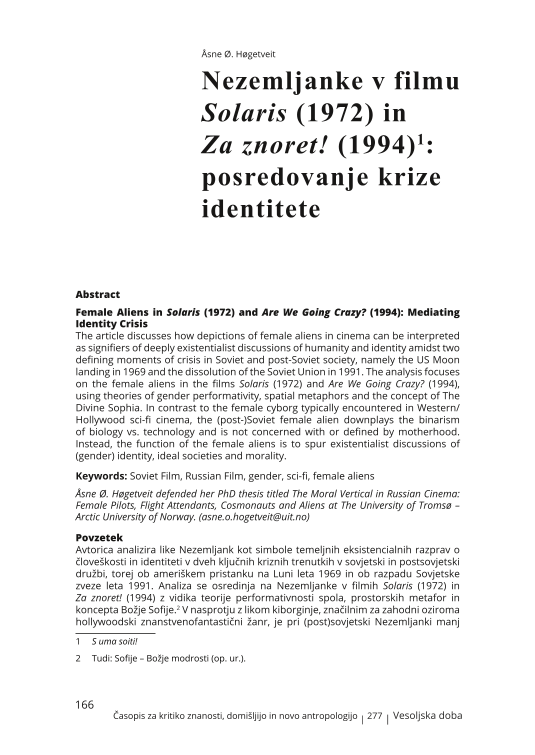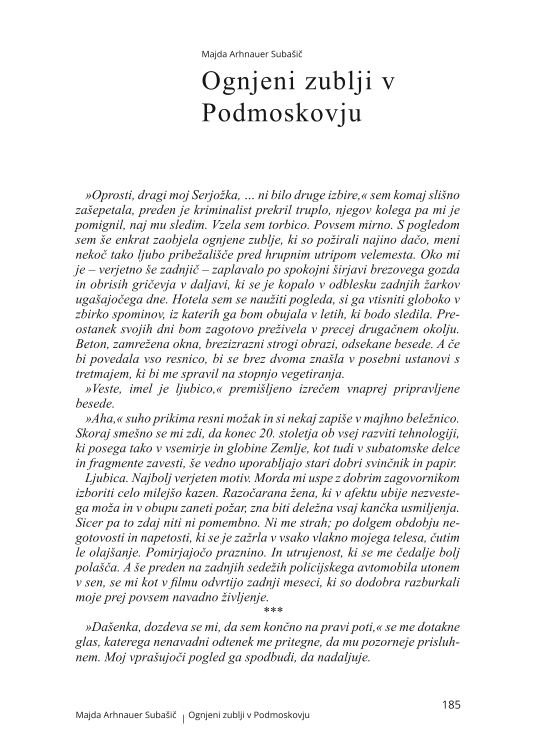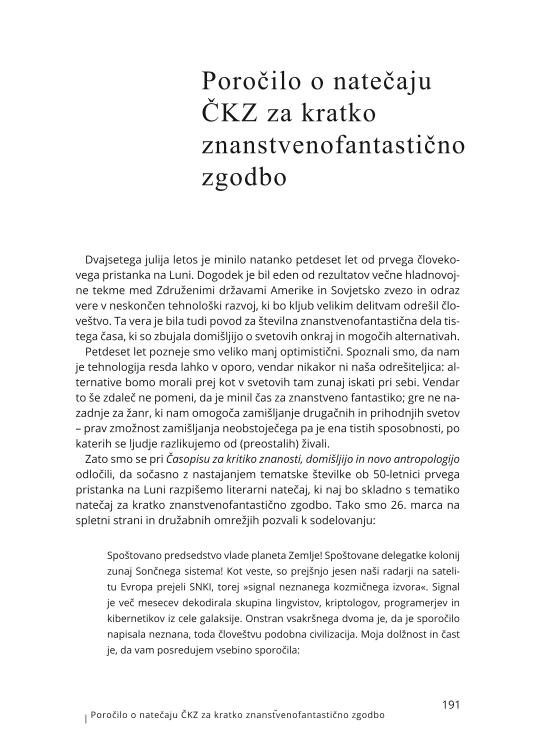Odmevne vesoljsko obarvane obletnice, praviloma polstoletnice, ki se vrstijo od leta 2007, 50-letnice izstrelitve prvega umetnega satelita, sovjetskega Sputnik-1, nehote kličejo po raznih kontekstualizacijah. Na zelo poseben način to velja za tiste obletnice, ki se nanašajo na neposredna srečanja med človekom in vesoljem. Najslavnejše od teh so slikovito uprizorili pristanek na Luni ameriškega vesoljskega plovila Apollo 11 in koraki astronavtov Neila Armstronga in Edwina »Buzza« Aldrina na Zemljinem naravnem satelitu in tema dvema je posvečena tudi pričujoča številka Časopisa za kritiko znanosti, domišljijo in novo antropologijo. Namen številke je predstaviti in kri-tično prevetriti nekaj pomembnih časovnoprostorskih koordinat, s pomočjo katerih si danes osmišljamo pomenljivost pristanka na Luni, zanašajoč se na aktualne teoretske nastavke in metodološke vstope, s katerimi operirata sodobna humanistika in družboslovje. Zato se bo ob pregledu člankov, zbranih v tej tematski številki, komu neogibno lahko zazdelo, da je izbor tekstov eklektičen, da dreza na različna področja, odpira vprašanja in ne zakoliči nobene končne sodbe ali vsaj univerzalne teze, kot bi se nemara spodobilo za obletnico. Takšna ta številka tudi je; na orisani način je, kot bo poskusil prikazati uvodnik, zasnovana namensko.
When Galileo observed the Moon with his telescope, he was particularly attracted by the shadows on its surface. As he wrote in Sidereus Nuntius (1610), the shadows led him to recognize that there are mountains and valleys on the Moon, just like on the Earth. This discovery had important implications that Christian theologians were initially reluctant to accept, since the Earth and the Moon became “equivalent” celestial globes that shared reflections of the Sun’s light. Fifty years ago, when the astronauts of the Apollo mission landed on the Moon and saw the “Earthrise” with their own eyes, the vision of our world emerging from the darkness was deeply impressive ...
The author shows how Galileo Galilei formed a scientific, phenomeno-technical gaze that allowed the phenomenon of the Moon to emerge within the framework of science-guided phenomenology. Galilei was a representative of the pre-existing anti-Aristotelian paradigm of the similarity of the Moon and Earth, and used a telescope in his exploration of celestial bodies. The latter represents the basis of the central thesis of the paper, which states that Galileo’s gaze through the telescope is not a natural gaze, but is instead a scientific-epistemological gaze that is formed by the scientific process itself. This opened the door for the Moon to come into existence as a phenomenon of scientific, objective phenomenology. In this sense, Galileo saw “things never seen before”, which also provided an insight into “thoughts never thought before” (Koyré, 1988: 78).
The article begins with a brief illustration of the Moon as a specific phenomenon with “thousands of gazes”, and continues with the central theme of the paper – the scientific gaze at the moon. The author briefly outlines the Aristotelian and anti-Aristotelian paradigms to show how Galilei’s thought is rooted within the latter. The central part of the text aims to analyse the process in which an epistemological, theoretical-technical gaze is formed, providing insight into the theoretical-technical phenomenon of the Moon.
Two of the most significant products of NASA’s Apollo Program were not new technologies, but photographs of the Earth from space that animated an entire worldview. In 1987, American author and aerospace engineer Frank White coined “The Overview Effect” to describe a positive mental shift reported by astronauts after viewing the Earth from outer space. Since then, White’s idea has become popular with space psychologists, space industry advocates, politicians, environmental and peace movements, and most recently, members of the public with an interest in space exploration. White argues that Overview is a naturally-occurring phenomenon that affirms his belief that humanity’s destiny is to colonize the cosmos. This paper argues against the “naturalness” of The Overview Effect by exploring three historical cases. First, the author examines the cold war military origins of three ideas framing Overview: the “Gaia Hypothesis”, the concept of “Space Ship Earth”, and the “Blue Marble” photograph taken during the Apollo 17 mission in 1972. The author continues by examining the deep tensions between astronauts and psychologists which have compromised astronaut self-reporting. The author also revisits a different idea from the 1950s called “The Break-Off Phenomenon”, where pilots reported feeling depressed, anxious, disconnected, and physically separated from the planet below—a pessimistic view at odds with Overview. The author argues that perceptions of natural places, including the Earth seen from space, are deeply cultural and historical, and always undergoing change. The Overview Effect isn’t a natural phenomenon, but rather just one of many possible ways of experiencing this view, one animated by Cold War-era Western-centric desires for space colonization.
This short essay briefly revisits some of the key issues and controversies associated with drafting the Outer Space Treaty (1967) and the Moon Agreement (1979). Drawing on Hannah Arendt’s critique of the Space Age, author argues that both treaties were a concerted attempt to think through the effects and process of space exploration not from the standpoint of the scientist for whom reaching the Moon and exploring the cosmos represented another stage in the progress towards an abstract universal standpoint. Rather, the treaties represented an attempt to read history into the future and to generate a radical normative break with historical patterns of colonialism and domination—a chance to inject equity and justice into the future of humankind.
“Space Technology has Produced a Reality Stronger than Our Political Reality.” An Interview with Miha Turšič
(
What is the role of art in space institutions and how can one think about outer space in the context of artistic initiatives? Miha Turšič is a co-founder of the Cultural Centre of European Space Technologies (KSEVT Vitanje) and a project developer at the Dutch-based Waag society, which develops socially-progressive, fair, and inclusive connections between science, technology, and art. In the interview, he addresses the outlined questions through a combination of conceptual and methodological reflections, as well as references to specific artistic initiatives and projects that interrogate and re-assess contemporary approaches to space exploration. In doing so, Turšič highlights the effects that the development of space technology has had on the ways in which humans understand their existence on Earth.
Overcoming Gravity at the Intersection of Art and Technology: The Example of Russian Constructivism
(
The article highlights the wider cultural and historical context of space exploration and interest in vastness which, particularly in Russian history, exceeds the ideological frames of the Cold War and the Space Race. A strong interest in the cosmos and the cosmic is a particularity of the Russian tradition, and we can see it expressed in theoretical texts and works of art and literature of the 20th century. By exploring new connections in the Russian tradition that are not related solely to the Soviet rocket program or the ideology of the Cold War, the article goes against the generally accepted reception which equates Russian interest in space with the desire to defeat the Americans in the Space Race. While contributing to the understanding of the cosmic tradition in Russian culture is one of the article’s goals, the text is also relevant as a reflection on the general context of thought contributing to a major event such as the Moon landing.
The article highlights Russian Constructivism as special period in Russian culture. It was an avant-garde artistic movement closely related to the ideas of flight and triumph over spatial and temporal boundaries which are contained in the concept of liberating the human of all forces (including the force of gravity). The author clearly outlines the movement’s orientation towards synthesis and the unification of science, technology and art, which makes the specifics of the principle of “machine” and “organic”, applied by Russian Constructivism to technology, especially evident.
What Will the Post-Planetary Future Look Like? An interview with Angelo Vermeulen and Nils Faber
(
To a considerable degree, the development of contemporary space technologies depends on the conceptual starting points that determine our understanding of outer space and interstellar space, as well as the meanings, ways, and forms of human interventions in space. In the framework of the SEAD (Space Ecologies Art and Design) interdisciplinary collective of artists, scientists, engineers, and activists, and with the help of references to specific projects, artist, biologist, and space systems researcher Angelo Vermeulen and product designer Nils Faber highlight how a polylogue between culture, science and experts from different fields contributes to scientific breakthroughs. Referring to their current E|A|S (Evolving Asteroid Starships) project, they sketch out a way of thinking about a post-planetary future of humanity in space and emphasize how this contemporary vision brings together several generations of science-fictional and scientific ideas.
On stage, science fiction often maneuvers between extrapolation, interpolation and actualization; between entertainment, spectacle and experiment. The following essay is an attempt to think about the relationship between science fiction in theatre and space flights, primarily focusing on the mechanisms and processes of performing and mediating sensory experiences. In the first part, the author briefly discusses the dialectical entanglement of science and fiction. In the second part, the author explores travels to and through space in three plays: Intracom (1974), a short play by Ursula Le Guin, Space Opera Zero, written by Eric Woolfe and produced by Eldrich Theatre, and Živadinov’s Gravitation Zero / Biomechanics Noordung (1999). These examples offer an illustration of the conceptual framework discussed in the first part. The analysis is focused on exploring the inner workings of (cognitive) estrangement and the oscillations between depictions of both intimate relationships and the cosmic width that inevitably confronts audiences with the unknown.
Female Aliens in Solaris (1972) and Are We Going Crazy? (1994): Mediating Identity Crisis
(
The article discusses how depictions of female aliens in cinema can be interpreted as signifiers of deeply existentialist discussions of humanity and identity amidst two defining moments of crisis in Soviet and post-Soviet society, namely the US Moon landing in 1969 and the dissolution of the Soviet Union in 1991. The analysis focuses on the female aliens in the films Solaris (1972) and Are We Going Crazy? (1994), using theories of gender performativity, spatial metaphors and the concept of The Divine Sophia. In contrast to the female cyborg typically encountered in Western/ Hollywood sci-fi cinema, the (post-)Soviet female alien downplays the binarism of biology vs. technology and is not concerned with or defined by motherhood. Instead, the function of the female aliens is to spur existentialist discussions of (gender) identity, ideal societies and morality.
»Oprosti, dragi moj Serjožka, … ni bilo druge izbire,« sem komaj slišno zašepetala, preden je kriminalist prekril truplo, njegov kolega pa mi je pomignil, naj mu sledim. Vzela sem torbico. Povsem mirno. S pogledom sem še enkrat zaobjela ognjene zublje, ki so požirali najino dačo, meni nekoč tako ljubo pribežališče pred hrupnim utripom velemesta. Oko mi je – verjetno še zadnjič – zaplavalo po spokojni širjavi brezovega gozda in obrisih gričevja v daljavi, ki se je kopalo v odblesku zadnjih žarkov ugašajočega dne. Hotela sem se naužiti pogleda, si ga vtisniti globoko v zbirko spominov, iz katerih ga bom obujala v letih, ki bodo sledila. Preostanek svojih dni bom zagotovo preživela v precej drugačnem okolju. Beton, zamrežena okna, brezizrazni strogi obrazi, odsekane besede. A če bi povedala vso resnico, bi se brez dvoma znašla v posebni ustanovi s tretmajem, ki bi me spravil na stopnjo vegetiranja.
Dvajsetega julija letos je minilo natanko petdeset let od prvega človekovega pristanka na Luni. Dogodek je bil eden od rezultatov večne hladnovojne tekme med Združenimi državami Amerike in Sovjetsko zvezo in odraz vere v neskončen tehnološki razvoj, ki bo kljub velikim delitvam odrešil človeštvo. Ta vera je bila tudi povod za številna znanstvenofantastična dela tistega časa, ki so zbujala domišljijo o svetovih onkraj in mogočih alternativah.
Petdeset let pozneje smo veliko manj optimistični. Spoznali smo, da nam je tehnologija resda lahko v oporo, vendar nikakor ni naša odrešiteljica: alternative bomo morali prej kot v svetovih tam zunaj iskati pri sebi. Vendar to še zdaleč ne pomeni, da je minil čas za znanstveno fantastiko; gre ne nazadnje za žanr, ki nam omogoča zamišljanje drugačnih in prihodnjih svetov – prav zmožnost zamišljanja neobstoječega pa je ena tistih sposobnosti, po katerih se ljudje razlikujemo od (preostalih) živali.
Celjsko literarno društvo je nastalo 30. maja 2001 na pobudo nekaj entuziastk (ja, pri zagonu so bile glavne ženske). Prvi predsednik društva je bil dr. Zoran Pevec, uveljavljen slovenski pesnik, ki ga je vodil polna dva mandata, vse do leta 2009; v tem času se je društvo, ki že od same ustanovitve izdaja revijo za kulturo in literaturo Vsesledje (letos je izšla že 38. izdaja), utrdilo in uveljavilo v celjskem prostoru. Vodenje društva sta po Pevcu prevzela prof. Metka Hojnik Verdev in prof. Ivan Janez Domitrovič, od leta 2017 ga vodim Bojan Ekselenski.
Društvo se ves čas vsebinsko širi in postaja vse pomembnejši deležnik v celjski in slovenski ljubiteljski kulturi; posegamo tudi na literarna področja, ki jih ostala ljubiteljska literarna društva ne pokrivajo. Od leta 2014 smo redni udeleženci Slovenskega knjižnega sejma v Cankarjevem domu, za katerega vedno pripravimo predstavitev aktualnih knjižnih izdaj članov. Smo edini promotor ljubiteljske literature na tem sejmu. Društvo in njegovi člani se udeležujemo tudi različnih dogodkov v Celju in širše, povezujemo se s sorodnimi društvi, zlasti KUD Police Dubove, v zadnjih letih smo bili gostje na nekaterih tujih kulturnih dogodkih, na katerih smo predstavljali raznolike in kakovostne vsebine lastnih revij. Revija Vsesledje, v kateri objavljajo tudi nekateri tuji avtorji (do zdaj iz petih različnih držav), je v zadnjih letih postala vsebinsko verjetno najbogatejša literarna revija, ki jih izdaja kakšno ljubiteljsko društvo.
The films of contemporary Croatian director Dalibor Matanić, who has been active since 2000, are conspicuously absent from the most thorough study on the subject of cosmopolitan humanism in post-Yugoslav cinema, Dino Murtić’s 2015 monograph Post-Yugoslav Cinema: Towards a Cosmopolitan Imagining. In this contribution, a thesis is proposed that Matanić’s work stands as a shining example of post-Yugoslav cinema’s humanism, cosmopolitan humanism included. In order to prove that, Murtić’s theory of cosmopolitanism in post-Yugoslav cinema is showcased, along with its forerunner, the post-Yugoslav stylistic current of »the film of normalization« as advocated by Jurica Pavičić (2011; Pavičić, as well, chose to bypass Matanić’s opus in his study). By attentively observing Matanić’s films, we show how they fit Murtić’s and Pavičić’s criteria nicely. A conclusion is reached that Matanić’s opus does not merely represent a most welcome rejuvenation of Croatian cinema in the last two decades, it is furthermore an important contribution on the part of arts to comprehend the mental landscape of Southeastern Europe, and a prism through which this very particular geopolitical region can be viewed as showing promise for a peaceful coexistence of different cultures. The post-Yugoslav cinema’s cosmopolitanism, as pursued by, among others, Matanić, provides a ray of hope that the future of this region is nevertheless bright.





